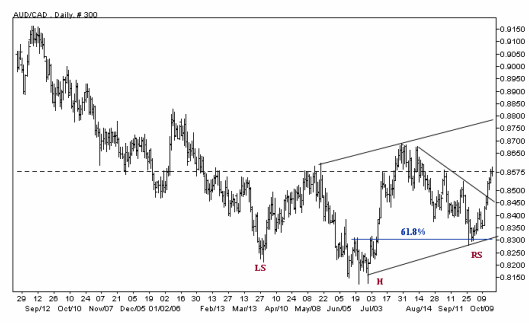AUD/CAD: trade of the year revisited
Those of you who have been reading our analysis since the
start of 2006 will recall an early January report we issued titled “The Trade of
the Year†recommending a core long position in AUDCAD. The rationale for that
trade was based on a breach of trendline resistance, positive carry, and
interest rate expectations for the two central banks over the course of the
year. While the initial signal proved to be premature, the fundamentals were
rather accurate. This morning, our SignalZone service recommended a long
position in USDCAD at 1.1360 ahead of the Bank of Canada decision in addition to
being a hedge to our dollar short exposure via the aussie. Having aligned our
short-term trade signals with our long-term “basket of tradesâ€, we thought it
may be helpful to look at the broader picture for this synthetic cross. The
results confirm our outright bullish bias for the long term
Textbook Technicals :
1) After a protracted decline, AUDCAD is finally showing signs
of a turnaround with an inverse “head and shoulders†pattern, confirmed further
by a rising neckline from the May to July highs.
2) The initial correction has ended at the tip of the 61.8%
retracement from the late July high without a single daily close below the
critical 0.83 level. Further upside beyond 0.87 is now highly likely.
3) The bottoming at the “Head†portion of the formation is a
classic double-bottom, long-tailed on both counts for added bullish measure.

Fundamentals ( What is Different from January ) :
1) The halt on interest rate tightening by the Bank of Canada
has long been confirmed. Today’s statement addressing weaker than expected GDP
growth implies the possibility of an interest rate cut by the BOC in early 2007.
As the markets begin to price this in, the yield luster of the loonie should
suffer.
2) Canada’s weaker than expected GDP growth is specifically
attributed to weakness in net exports. In other words, Canada’s manufacturers
are finding it increasingly more difficult to sell their goods. The reason for
this is two-fold: one, the loonie has become too dear of a currency to trade for
so as to purchase Canadian goods; two, Canada’s largest trading partner — the US
— is undergoing an economic slowdown and loans have become much more expensive.
By contrast, Australia’s largest trading partner — Japan — is at the dawn of the
economic recovery that is supported by an accommodative central bank.
3) Despite a correction in commodities and weaker growth, the
outlook for continued tightening by Australia’s central bank remains promising.
Last week’s unexpected decline in unemployment should prompt the new RBA
Governor Glenn Stevens to assert his inflation-fighting credentials with another
hike before the end of the year.
Jes
Black is the fund manager at Black Flag Capital Partners and Chairman of
the firm’s Investment Committee, which oversees research, investment and
trading strategies. You can find out more about Jes at
BlackFlagForex.com.
Prior
to organizing the hedge fund he was hired by MG Financial Group to help
run their flagship news and analysis department,
Forexnews.com. After four
years as a senior currency strategist he went on to found
FxMoneyTrends.com – a research firm catering to professional traders.
